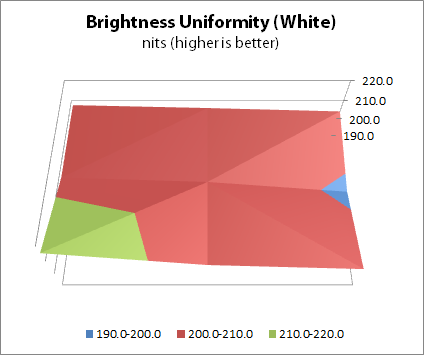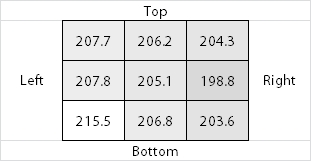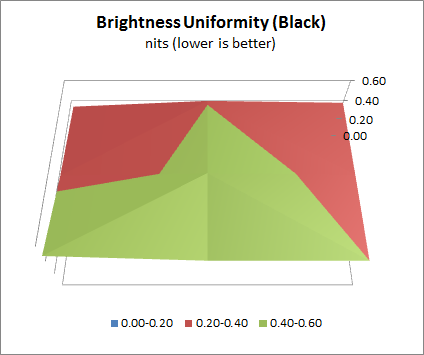NEC PA301w: The Baddest 30-inch Display Around
by Brian Klug on March 1, 2011 8:00 AM ESTBrightness Uniformity
For brightness uniformity, we test at the same 9 points we measure Delta-E on, but this time measure white and black levels when the center point is as close to 200 nits as we can get. We use the same colorimeter and software as before, - an Xrite i1D2 and ColorEyes Display Pro. Similar to the ordinary brightness test (taken at the center), contrast is set to 100 in the OSD and brightness is set to as close to 200 as possible in the center before measurements are taken.
White Uniformity


Black Uniformity


It appears that the PA301w's built-in uniformity settings help keep the brightness profile very steady in the full on white test. There's a tiny horizontal dependence from left to right, but it's imperceptible in practice, and the standard deviation of these readings is just 4 nits. Uniformity in the white department is actually very good.
Blacks are a little worse, again the bottom left seems to be brighter than the rest of the display by a measurable and consistent amount. On the whole again though the consistency is pretty good. Displaying a purely black image, there's also no obvious light leakage anywhere on the display.










92 Comments
View All Comments
Seanrus - Wednesday, March 2, 2011 - link
This is first time on andtech that I've read a review that I would consider clearly biased. I follow development of 30 inch monitors closely for a last couple of years, since I want one but not yet committed to it.My reasoning is that in final thought writer, at least, should have mentioned about the relative price point to other 30" monitors. If that was done it would be clear that this monitor does not fit well anywhere in the market of 30" monitors.
Just bellow it, in performance, is HP ZR30 w which is can be acquired for $1100-1200 (for half the price) and performs very closely to this NEC.
As result the only consumers that might consider this monitor for whom the price is not the option, but then there are monitors in 5K range that perform even better than this one.
Also from the gamer perspective, which I speculate is the biggest audience here, ZR30w probably will be a better choice, because NEC, most likely, will not perform as well on response time as ZR30w since NEC has OSD (and that slows down response time as described in recent dell 30" monitor review.) This is a speculation and we need to wait for the results for response time to be posted.
Finally, I got an impression from this article that being big and heavy is a good thing (unfortunately I do not think phrase form Snatch "If it does not work, you can hit with it" would apply here.) Even the title of the article emphasizes that. This big and heavy quality of the monitor is defensibly a drawback, especially when it is 20lb heavier than other 30" monitors.
Conclusion that I came to from this article is that this monitor is nothing to be excited about, and is not a good buy for any consumer/prosumer segment. Performance benefits, and extra features that this NEC monitor has do not justify a $1000 premium.
strikeback03 - Wednesday, March 2, 2011 - link
It is a product marketed at a professional audience, with a price and some features to match. Many people have been wondering how the "cheap" 30" displays compare to some of the options targeted at professionals, now they have a comparison. Yes, gamers are better off buying a cheaper one.erple2 - Wednesday, March 2, 2011 - link
I got the gist not that being big and heavy was a good thing, but that it wasn't a bad thing.bossanova808 - Thursday, March 3, 2011 - link
If the colour accuracy stuff in this review had been done properly, then you would have seen the NEC way out in front of the HP and, for the target market, that's pretty important. Not saying the HP doesn't make sense for gamers, but for the pro image makers that NEC are targetting, the PA30 is a spectacular device from a performance/price point of view when compared to it's real competition which is the CG303W from Eizo (and that's about it).8steve8 - Wednesday, March 2, 2011 - link
no LED illumination = no buybossanova808 - Thursday, March 3, 2011 - link
A disaster from a colour accuracy persepctive, hence no LED as it's not appropriat for the target market - same as EIzo don't do LED monitors.Soldier1969 - Wednesday, March 2, 2011 - link
with these days of half inch thick led panels this thing looks like something from 6 or 7 years ago. $2300 not thanks. Im just fine with my 30" HP ZR30w super ips panel you last reviewed. Works great and im still in awe of it with gaming and daily use. $1200 much better spent.lemonadesoda - Wednesday, March 2, 2011 - link
Yes, this is a nice 2560x1600 30"er.But where is the innovation? Where are the higher pixel density displays. Those that want 2560x1600 displays but in a more manageable 24" or 27" format?
And what about ultra-hi resolution like 3840x2160 in 27"? Allowing you to read documents/PDFs in near-print DPI quality. Why is no-one making these?. the panels ARE available! http://www.chimei-innolux.com/opencms/cmo/products...
tzhu07 - Thursday, March 3, 2011 - link
I currently own the NEC PA271W, the little brother to this monitor. I kind of prefer the 271 over the 301 because it has a finer dot pitch, therefore I don't have to move my head around as much. You do lose 160 horizontal lines, but it's really not too much of a big deal. It's the best monitor I've used so far.Those with poorer eye sight though should get the 301.
Beka - Thursday, March 3, 2011 - link
Does this nec screen have a good scaler like the dell?Being able to play at lower resolution while having games that still look good is great feature of the dell.